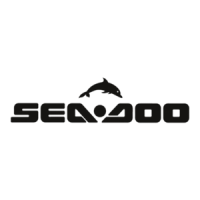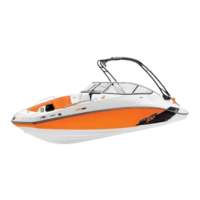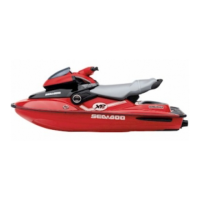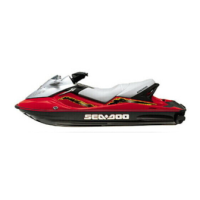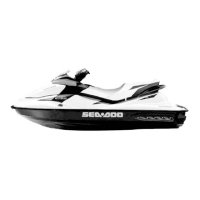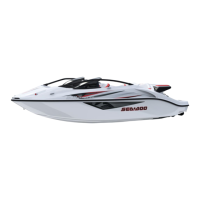Do you have a question about the Sea-doo 210 Challenger/SP and is the answer not in the manual?
Learn to reduce accident risk by reading specific sections and safety labels.
Explains types, appearance, and usage of safety messages in the guide.
Details the purpose and use of the Operator's Guide for proper boat operation.
Provides crucial safety reminders for boat operation and awareness.
Details risks and symptoms of CO poisoning and prevention measures.
Outlines essential pre-departure checks and preparations for safe operation.
Emphasizes operator responsibility and passenger safety awareness.
Safety guidelines for various water sports activities like skiing and wakeboarding.
Explains hypothermia risks and provides tips for staying warm and increasing survival time.
Information on courtesy inspections for boat safety compliance.
Recommendation and requirement for boating safety courses.
Lists essential safety equipment mandated by regulations for boat operation.
Details PFD regulations, types, and selection criteria for boat safety.
Information on fire extinguishers, visual distress signals, sound devices, and navigation lights.
Lists optional gear recommended for enhancing safety and enjoyment during cruising.
Guidelines for selecting a suitable area for practicing boat handling exercises.
Details specific exercises like turning, stopping, and reverse operation.
Highlights factors affecting boat behavior and response during operation.
Warns against operating a boat under the influence of drugs or alcohol.
Emphasizes pre-ride checks, passenger safety, first aid, and minor operation rules.
Covers general operating rules, laws, and safety practices for navigating waterways.
Explains navigational aids like signs and buoys for safe water identification.
Provides tips and rules for preventing collisions with other watercraft and objects.
Specifies the type and octane rating of fuel recommended for the boat.
Step-by-step instructions for safe and proper fueling of the boat.
Outlines essential steps and precautions to take when trailering the boat.
Details Hang Tags, Safety, Compliance, and Technical labels found on the boat.
A checklist for pre-ride inspection when the boat is trailered.
A checklist for pre-ride inspection when the boat is docked.
Details primary controls like steering, throttle, ignition, and switches.
Explains switches for lights, heating, ballast, and buttons for modes and settings.
Describes Speedometer, Fuel Level, and Voltmeter gauges.
Covers the information center, pilot lamps, digital displays, and modes.
Details seats, grab handles, ladder, swim platform, and bimini top for user comfort and access.
Describes various storage compartments, glove box, and access points.
Covers radio, power outlets, audio ports, lights, and drains for boat functionality.
Explains eyelets, cleats, ski pole, tow hook, towing tower, heating, ballast, and cockpit table.
Provides instructions and notices for proper engine break-in procedures.
Procedures for launching, boarding, and starting the boat's engines safely.
Covers steering, engaging gears (neutral, forward, reverse), and general recommendations.
Details stopping, docking, docking mode, and beaching procedures.
Details the SKI MODE for adjusting launch intensity and maintaining speed.
Explains the CRUISE mode for maintaining steady speed over long distances.
Describes the SYNC mode for synchronizing twin engines' RPM.
Procedures for cleaning jet pump intakes to prevent damage and overheating.
Precautions to take when towing the boat in water, including hose pinchers.
Procedure to limit engine damage if the boat is submerged.
Covers break-in inspection and the general maintenance schedule.
Details engine oil, coolant, ignition coils, exhaust system flushing, and related tasks.
Covers fuses, circuit breakers, lights, drains, latches, gates, and anodes.
Daily care, anticorrosion, salt water use, and general cleaning tips.
Guides for cleaning vinyl, stainless steel, chrome, and preventing corrosion.
Protecting exhaust, intercoolers, and engines internally for storage.
Covers coolant testing, battery, cleaning, repair, and overall boat protection for storage.
Performing preseason maintenance tasks, often with dealer assistance.
How to identify the boat and engine using serial numbers.
Information on emission control devices, manufacturer, dealer, and owner responsibilities.
Technical specifications for engine, cooling, electrical, and fuel systems.
Guidance for diagnosing and solving common boat problems.
Covers engine starting, running, overheating, power loss, and smoke issues.
Addresses top speed, propulsion noise, and bilge water problems.
Explains indicator lights and messages for system status and faults.
Interprets beeper codes for system alerts and warnings.
Details warranty terms, conditions, and procedures for US and Canada.
Covers California emission warranty rights, manufacturer coverage, and owner responsibilities.
Contact information and procedures for seeking assistance with warranty issues.
Contact details for European and other international consumers seeking assistance.
Information on how BRP uses customer data for safety, warranty, and marketing purposes.
Procedures for notifying BRP about address changes or ownership transfers.
